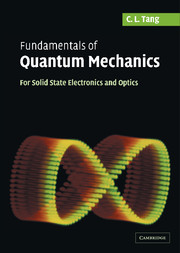Book contents
- Frontmatter
- Contents
- Preface
- 1 Classical mechanics vs. quantum mechanics
- 2 Basic postulates and mathematical tools
- 3 Wave/particle duality and de Broglie waves
- 4 Particles at boundaries, potential steps, barriers, and in quantum wells
- 5 The harmonic oscillator and photons
- 6 The hydrogen atom
- 7 Multi-electron ions and the periodic table
- 8 Interaction of atoms with electromagnetic radiation
- 9 Simple molecular orbitals and crystalline structures
- 10 Electronic properties of semiconductors and the p-n junction
- 11 The density matrix and the quantum mechanic Boltzmann equation
- References
- Index
11 - The density matrix and the quantum mechanic Boltzmann equation
Published online by Cambridge University Press: 05 June 2012
- Frontmatter
- Contents
- Preface
- 1 Classical mechanics vs. quantum mechanics
- 2 Basic postulates and mathematical tools
- 3 Wave/particle duality and de Broglie waves
- 4 Particles at boundaries, potential steps, barriers, and in quantum wells
- 5 The harmonic oscillator and photons
- 6 The hydrogen atom
- 7 Multi-electron ions and the periodic table
- 8 Interaction of atoms with electromagnetic radiation
- 9 Simple molecular orbitals and crystalline structures
- 10 Electronic properties of semiconductors and the p-n junction
- 11 The density matrix and the quantum mechanic Boltzmann equation
- References
- Index
Summary
While the dynamic state of a single particle can be specified quantum mechanically in terms of its state function, any rigorous description of the state of a many-particle system would require the complete knowledge of the dynamic state functions of all the particles. That is not always possible. On the other hand, for a large number of particles in, or near, thermal equilibrium in a uniform sample, the principles of statistical mechanics may be invoked to describe the averaged expectation values of the physically observable properties of such a many-particle system. The basic concepts of the density-matrix formalism and the quantum mechanic analog of the classical Boltzmann equation commonly used for optical and magnetic resonance problems of many-particle quantum systems are introduced in this chapter. Applications of this approach to such specific problems as the resonant interaction of electromagnetic radiation with optical media of two-level atoms, nonlinear optics, and the laser rate equations and transient dynamics are discussed in this chapter.
Definitions of the density operator and the density matrix
Up to this point, in studying the dynamics of quantum mechanic systems, we have assumed that the state of the system can be specified in terms of a precisely known state function |Ψ〉. On the other hand, for a macroscopic medium containing many particles, it is not always possible to know the exact dynamic states of all the particles in the medium, even for physically identical particles.
- Type
- Chapter
- Information
- Fundamentals of Quantum MechanicsFor Solid State Electronics and Optics, pp. 182 - 203Publisher: Cambridge University PressPrint publication year: 2005



